
Princess Peach Toadstool is a recurring fictional character in Nintendo's Mario franchise, created by Shigeru Miyamoto and introduced in the 1985 original Super Mario Bros. installment. She is the princess regnant and head of state of the Mushroom Kingdom, where she resides in her castle along with Toads.

Roberta Lynn Williams is an American video game designer and writer, who co-founded Sierra On-Line with her husband, game developer Ken Williams. In 1980, her first game, Mystery House, became a modest commercial success; it is credited as the first graphic adventure game. She is also known for creating and maintaining the King's Quest series, as well as designing the full motion video game Phantasmagoria in 1995.

The Longest Journey is a magical realist point-and-click adventure video game developed by Norwegian studio Funcom for Microsoft Windows and released in 1999.

Dragon Tales is an animated educational fantasy children's television series created by Jim Coane and Ron Rodecker, developed by Coane, Wesley Eure, Jeffrey Scott, Cliff Ruby and Elana Lesser, and produced by Children's Television Workshop, Sesame Workshop, Columbia TriStar Television, Sony Pictures Television and Adelaide Productions. The series focuses on the adventures of two siblings, Emmy and Max, and their dragon friends Ord, Cassie, Zak, Wheezie, and Quetzal.
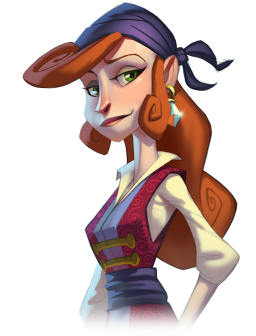
Elaine Marley is a character in the Monkey Island series of graphic adventure video games. Created by Ron Gilbert for LucasArts, the character first appears in The Secret of Monkey Island and is one of the core characters in the franchise. Originally conceived as a ruthless island governor, the character evolved during development into the protagonist's love interest. While the first two games in the series did not feature voice acting, Elaine was voiced by Alexandra Boyd in The Curse of Monkey Island and by Charity James in Escape from Monkey Island; Boyd would reprise the role for later entries in the franchise.

King's Quest VI: Heir Today, Gone Tomorrow is a point-and-click adventure game, first released in 1992 as the sixth installment in the King's Quest series produced by Sierra On-Line. Written by Roberta Williams and Jane Jensen, King's Quest VI is widely recognized as the high point in the series for its landmark 3D graphic introduction movie and professional voice acting. King's Quest VI was programmed in Sierra's Creative Interpreter and was the last King's Quest game to be released on floppy disk. A CD-ROM version of the game was released in 1993, including more character voices, a slightly different opening movie and more detailed artwork and animation.
Transylvania was the name of a trilogy of computer games released for several home computers of the 1980s. The games were graphic adventure games created by Antonio Antiochia and produced by Penguin Software/Polarware.

Jessica Sonya DiCicco is an American actress. She is known for voicing in animated television series and video games. Her first voice role was the announcer for Nickelodeon's educational channel Noggin. DiCicco has since voiced various other characters for Nickelodeon, including Gwen Wu in The Mighty B!, Selina and Miele in Winx Club, Lucy Loud and Lynn Loud in The Loud House, and Annie Bramley in It's Pony.
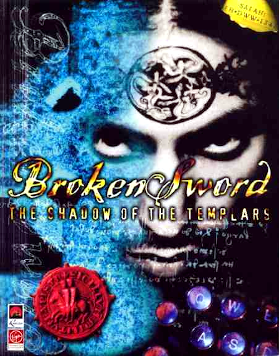
Broken Sword: The Shadow of the Templars is a 1996 point-and-click adventure game developed by Revolution Software. It is the first in the Broken Sword series, co-written and directed by Charles Cecil. The player assumes the role of George Stobbart, an American tourist in Paris, as he attempts to unravel a deep conspiracy involving a sinister cult and a hidden treasure, seeing him travel to various locations around Europe and the Middle East. The game's storyline was conceived to feature a serious tone and heavily influenced by research on Knights Templar by Cecil, but was also interlaced with humor and graphics in the style of classic animated films.
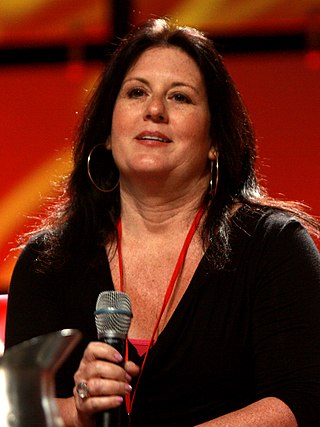
Sandra Marie Fox is an American voice actress who has had numerous roles in various animated cartoon, anime and video games. She portrayed the live-action Betty Boop and has provided her voice for Universal Studios and King Features Syndicate for much of their promotional activities and related media and merchandise from 1991 to 2018. She began voice acting on various animated shows such as The Simpsons, King of the Hill and Futurama. Her first major roles in anime were as Kiyoko in the Animaze dub of Akira and Lady Aska in Magic Knight Rayearth. Other anime characters include Mina and Momiji in Naruto, Sumomo in Chobits, Tachikoma in Ghost in the Shell: Stand Alone Complex, and Paiway in Vandread. In video game franchises, she provides the English voice of Mistral and A-20 in the .hack series, Peashy in Hyperdimension Neptunia, and Flonne in Disgaea. In cartoons, she voices Harmony in Hi Hi Puffy AmiYumi and Mipsy Mipson in As Told by Ginger. In 2014, she was announced as the voice of Chibiusa/Black Lady/Sailor Chibi Moon in the Viz Media dubs of Sailor Moon and Sailor Moon Crystal.
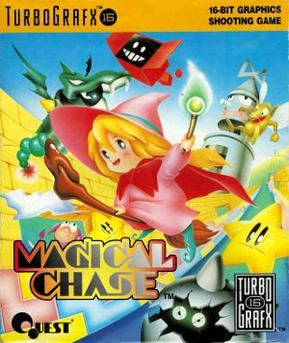
Magical Chase is a 1991 horizontally scrolling shooter video game developed by Quest and published by Palsoft and Turbo Technologies Inc. for the TurboGrafx-16. The game stars a young witch apprentice named Ripple, who broke a promise to her teacher by accidentally releasing six demons from a forbidden book, joined by her star companions Topsy and Turvy on a quest to catch and seal the demons back into the book.
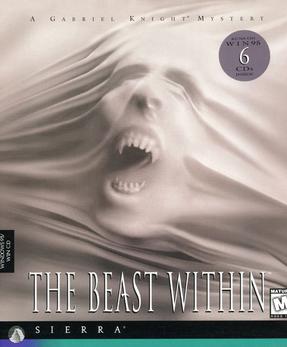
The Beast Within: A Gabriel Knight Mystery is an interactive movie point-and-click adventure game, developed and published by Sierra On-Line for MS-DOS, Macintosh, and Microsoft Windows, and released in 1995. The live-action scenes star the talents of Dean Erickson and Joanne Takahashi in the game's lead roles. The sequel to 1993's Gabriel Knight: Sins of the Fathers and the second entry in the Gabriel Knight series, the game focuses on the lives of Gabriel Knight, an author who is descended from a family that combats supernatural evils, and Grace Nakimura, a student who assists Gabriel, as they become involved in a new case within Germany that focuses around a werewolf that has begun killing people around the city of Munich, and has connections to the lives of two famous people of Germany's history.
Moegaku (もえがく) is a series of English language study adventure games for PC and PSP developed by Studio Sagittarius. Based on the concept that was made popular by the Moetan series of English wordbooks, it tries to spark the interest of the player for language-learning with cute, moe characters and a setting that should feel familiar to otaku.
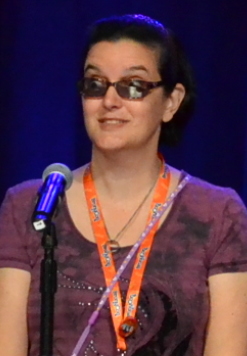
Charlotte Louise Fullerton is an American writer of television, novels, comic books and video games.

Navi is a fictional fairy who acts as series protagonist Link's navigator throughout the 1998 Nintendo 64 video game The Legend of Zelda: Ocarina of Time. She was voiced by Kaori Mizuhashi. Navi performs a variety of functions within the game, including being a companion and guide to Link, providing the player with advice and being a focal point for the game's Z-lock targeting combat system. She has been widely criticised by players and critics for her repetitive interruptions in gameplay, particularly with the prompt "Hey! Listen!".
An adventure game is a video game genre in which the player assumes the role of a protagonist in an interactive story, driven by exploration and/or puzzle-solving. The genre's focus on story allows it to draw heavily from other narrative-based media, such as literature and film, encompassing a wide variety of genres. Most adventure games are designed for a single player, since the emphasis on story and character makes multiplayer design difficult. Colossal Cave Adventure is identified by Rick Adams as the first such adventure game, first released in 1976, while other notable adventure game series include Zork, King's Quest, Monkey Island, Syberia, and Myst.

Jake Rodkin is an American video game designer, writer, graphic designer, and podcaster. He was the co-project leader of Tales of Monkey Island and the co-project leader and co-writer of The Walking Dead, Poker Night at the Inventory, and Puzzle Agent 2. He was also the director of the fifth episode of Sam & Max: The Devil's Playhouse, and designer and writer of Firewatch.
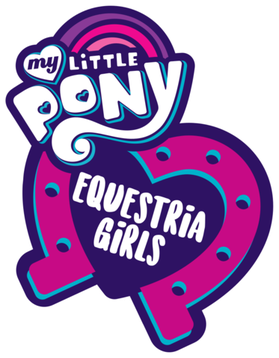
My Little Pony: Equestria Girls, simply known as Equestria Girls or EQG, is a product line of fashion dolls and a media franchise launched in 2013 by the American toy company Hasbro as a spin-off of the 2010 relaunch of the My Little Pony line of pony toys and its Friendship Is Magic television series. Equestria Girls features anthropomorphized versions of My Little Pony characters from that period; as with My Little Pony, which features a colorful body and mane, Equestria Girls characters sport non-human skin and hair colors, while incorporating their pony counterpart's cutie marks in their clothing. The franchise includes various doll lines, media tie-ins, and licensed merchandise.

Sif, the Great Grey Wolf is a character and boss in the 2011 action role-playing game Dark Souls. A wolf that has grown to a massive size, it protects the grave of its deceased master, Knight Artorias the Abysswalker, and the Covenant of Artorias, a ring that allows its wearer to traverse the Abyss, a dark void normally impassable by mortals. The fight with Sif has been cited by critics as one of the most memorable in the game due to the role reversal of the player as a transgressor. Sif also functions as an optional ally in the game's DLC.

Fallout: Equestria is a post-apocalyptic fan fiction novel based on the Fallout and My Little Pony: Friendship is Magic series. It was originally published by pseudonymous user Kkat on April 12, 2011. It is split into five volumes, totalling 620,000 words across more than 2,000 pages. The novel has been published as an ebook, an audiobook, and also as a physical hardcover novel. The novel is considered to be one of the most popular My Little Pony: Friendship Is Magic fanworks, having developed a large following of its own.

















